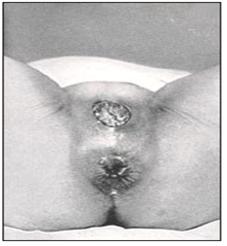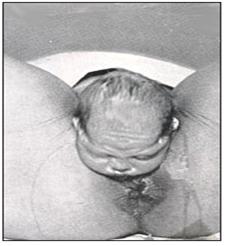B군 연구균 감염병 예방(B군 연구균 감염병 예방), Prevention for Group B streptococcal infections

사진 5-4. 질부 산도를 통과해서 태어나는 아기가 모체의 피, 점액, 소변, 또는 대변 등에 접촉될 때 모체로부터 B군 연구균에 감염되어 신생아에게 B군 연구균 감염병이 생길 수 있다
출처- 임신에서 신생아 돌보기까지와 De Lee and Greenhill: Principles and practice of obstetrics, W. B. Sounders

사진 5-5. 질부 산도를 통과해서 태어나는 아기가 분만부의 피, 점액, 소변, 또는 대변 등에 접촉될 때 분만부로부터 B군 연구균에 감염되어 신생아에게 B군 연구균 수막염, 패혈증 등 감염병이 생길 수 있다
출처- 임신에서 신생아 돌보기까지와 De Lee and Greenhill: Principles and practice of obstetrices, W. B. Sounders
| B군 연구균에 의한 감염병 예방(B군 연구균 감염병 예방)의 개요 |
- 연쇄상구균(연구균)은 A군, B군, C군, D군, E군, F군, G군 등 여러 혈청 군종으로 분류된다. 그중, 특히 신생아가 B군 연구균에 감염되면 신생아에게 여러 종류의 B군 연구균성 감염병이 생길 수 있다.
- 질 산도를 통과해서 태어날 때 분만부의 요로와 질산도 등에 보균하고 있던 B군 연구균이 산도를 통해 태어나는 신생아에게 감염되면 B군 연구균성 감염병이 신생아에게 생길 수 있다.
- 또 분만 후 산모가 B군 연구균에 감염되면 산모에게 B군 연구균성 패혈증, 또는 B군 연구균성 자궁 내막염 등이 생길 수 있다. 태반 융모 양막에 감염되면 B군 연구균성 융모 양막염이 생길 수 있다.
- 신생아들이나 생후 3개월 이전 영아들이 B군 연구균에 감염되면 B군 연구균성 폐렴, B군 연구균성 수막염, B군 연구균성 패혈증, B군 연구균성 골수염, B군 연구균성 관절염, B군 연구균성 봉소염, 그 외 여러 종류의 B군 연구균성 감염병이 신생아에게 생길 수 있다.
- 특히 생후 24시간 내 신생아가 B군 연구균에 감염되면 B군 연구균성 신생아 폐렴, B군 연구균성 뇌막염, B군 연구균성 패혈증 등이 생길 수 있고 그로 인해 호흡곤란, 저 체온증, 무호흡증, 쇼크 등의 증상이 생길 수 있다.
- 적절히 응급 치료를 받지 않으면 대개 그로 인해 신생아나 영아가 사망하는 것이 보통이다.
- 잠복기는 7일 정도이다.
- 병력, 증상 징후, 진찰, 산모의 소변, 질 세균검사 및 세균 배양검사, 신생아의 혈액, 소변과 뇌척수액 세균 검사와 세균 배양검사 등을 해서 그 결과를 종합해서 확진한다.
- 응급으로 치료한다.
- 페니실린이나 앰피실린 혈관주사로 치료한다.
| B군 연구균 감염병의 예방 |
- 미 CDC는 임신 36~37주에 모든 임신부의 질 강, 항문과 직장 등에 B군 연구균 전이식증이 있는지 진단하기 위해 임산부나 분만부에서 B군 연구균 세균 검사를 통상적으로 하고 B군 연구균이 검출되면 분만 시 모체에게 예방적 항생제 치료를 하라고 권장한다.
- 과거 임신부에게 태어났던 신생아에게 침입성 B군 연구균성 감염이 있었으면 분만 시 모체가 예방적 항생제 치료를 받도록 권장한다.
- 임신 37주 전, 분만이 이미 시작됐을 때, 또는 양막이 이미 파열됐을 때, 분만부의 질 강, 항문과 직장 등에 B군 연구균 전이식증이 있는지 알아볼 수 있는 B군 연구균 세균 검사 결과를 아직 모르거나, 그런 검사를 했는지 안 했는지 모르고 있을 때는 산모에게 예방적 항생제 치료를 하라고 권장한다.
Prevention for Group B streptococcal infections B군 연구균 감염병 예방(B군 연구균 감염병 예방)

Photo 5-4. When a baby born through the vaginal birth canal comes into contact with the mother’s blood, mucus, urine, or feces, it can be infected with group B Group B streptococcal bacteria from the mother and cause a group B Group B streptococcal infections, bacteria infectious disease in the newborn. Source- From Pregnancy to Newborn Care and De Lee and Greenhill: Principles and practice of obstetrics, W. B. Sounders

Photo 5-5. When a baby born through the vaginal birth canal comes into contact with the blood, mucus, urine, or feces of the delivery part, it can be infected with group B streptococcal bacteria from the delivery part and cause infectious diseases such as group B research bacteria meningitis and sepsis in the newborn. Source-From Pregnancy to Newborn Care and De Lee and Greenhill: Principles and practice of obstetrics, W. B. Sounders
Overview of the prevention of infectious diseases caused by group B streptococcal bacteria (prevention of infectious diseases of group B streptococcal bacteria)
Streptococcus (research bacteria) is classified into several serotypes such as group A, group B, group C, group D, group E, group F, and group G.
Among them, in particular, when a newborn is infected with group B streptococcal bacteria, several types of group B research bacteria infectious diseases can occur in newborns.
When a group B streptococcal bacteria, which was carried through the vaginal birth canal and carrying it in the urinary tract and the delivery part, is infected to a newborn born through the birth canal, a group B streptococcal bacteria infectious disease can occur in the newborn.
In addition, if the mother is infected with group B research bacteria after delivery, the mother may develop group B streptococcal bacterial sepsis or group B streptococcal bacterial endometritis.
Infection with the placental chorionic amniotic membrane can lead to group B streptococcal bacterial chorionic amniotic infection.
If newborns or infants before 3 months of age are infected with group B streptococcal bacteria such as,
1, group B streptococcal bacterial pneumonia,
2, group B streptococcal bacterial meningitis,
3. group B research bacterial sepsis,
4. group B research bacterial osteomyelitis, group
5. B research bacterial arthritis,
6. group B streptococcal bacterial cellulitis,
7. Several other types of group B streptococcal bacterial infectious diseases can occur in newborns.
In particular, if a newborn baby is infected with group B streptococcal bacteria within 24 hours of life,
- group B research bacterial neonatal pneumonia,
- group B streptococcal bacterial meningitis, group B research bacterial sepsis, etc. can occur.
- Symptoms may occur.
- Without adequate emergency care,
- it is common for a newborn or infant to die as a result.
- The incubation period is about 7 days.
- Medical history, symptoms, signs, examination, maternal urine, vaginal bacteriological and bacterial culture tests, newborn blood, urine, and cerebrospinal fluid bacterial tests and bacterial culture tests are performed, and the results are combined and confirmed.
- Treat as an emergency.
- Treat with penicillin or ampicillin vascular injection.
Prevention of infectious diseases of group B streptococcal bacteria
- The US CDC routinely tests for bacteria of group B research bacteria in pregnant women or delivery women to diagnose whether there is group B streptococcal bacteria in the vaginal cavity, anus, and rectum of all pregnant women at 36-37 weeks of pregnancy. If detected,
- it is recommended that the mother be treated with prophylactic antibiotics during delivery. If a newborn born to a pregnant woman in the past had an invasive group B bacterial infection,
- it is recommended that the mother receive prophylactic antibiotic treatment at delivery. 37 weeks before pregnancy, when labor has already begun, or when the amniotic membrane has already ruptured, the results of a group B streptococcal bacterial test that can detect if there is metastasis of group B streptococcal bacteria in the vaginal cavity, anus, and rectum of the delivery are not known yet.
- Or, if you do not know whether or not such a test has been performed, the mother is encouraged to take prophylactic antibiotic treatment.
출처 및 참조문헌
- Red Book 32nd Ed 2021 -2024
- www.drleepediatrics.com 제1권 소아청소년 응급 의료
- www.drleepediatrics.com 제2권 소아청소년 예방
- www.drleepediatrics.com 제3권 소아청소년 성장 발육 육아
- www.drleepediatrics.com 제4권 모유,모유수유, 이유
- www.drleepediatrics.com 제5권 인공영양, 우유, 이유식, 비타민, 미네랄, 단백질, 탄수화물, 지방
- www.drleepediatrics.com 제6권 신생아 성장 발육 육아 질병
- www.drleepediatrics.com제7권 소아청소년 감염병
- www.drleepediatrics.com제8권 소아청소년 호흡기 질환
- www.drleepediatrics.com제9권 소아청소년 소화기 질환
- www.drleepediatrics.com제10권. 소아청소년 신장 비뇨 생식기 질환
- www.drleepediatrics.com제11권. 소아청소년 심장 혈관계 질환
- www.drleepediatrics.com제12권. 소아청소년 신경 정신 질환, 행동 수면 문제
- www.drleepediatrics.com제13권. 소아청소년 혈액, 림프, 종양 질환
- www.drleepediatrics.com제14권. 소아청소년 내분비, 유전, 염색체, 대사, 희귀병
- www.drleepediatrics.com제15권. 소아청소년 알레르기, 자가 면역질환
- www.drleepediatrics.com제16권. 소아청소년 정형외과 질환
- www.drleepediatrics.com제17권. 소아청소년 피부 질환
- www.drleepediatrics.com제18권. 소아청소년 이비인후(귀 코 인두 후두) 질환
- www.drleepediatrics.com제19권. 소아청소년 안과 (눈)질환
- www.drleepediatrics.com 제 20권 소아청소년 이 (치아)질환
- www.drleepediatrics.com 제21권 소아청소년 가정 학교 간호
- Red book 29th-31st edition 2021
- Nelson Text Book of Pediatrics 19th- 21st Edition
- The Johns Hopkins Hospital, The Harriet Lane Handbook, 22nd edition
- Childhood Emergencies in the Office, Hospital and Community, American Academy of Pediatrics
- Emergency Medical Service for Children, By Ross Lab. May 1989. p.10
- Emergency care, Harvey Grant and Robert Murray
- Emergency Care Transportation of Sick and Injured American Academy of Orthopedic Surgeons
- Emergency Pediatrics A Guide to Ambulatory Care, Roger M. Barkin, Peter Rosen
- Immediate care of the acutely ill and injured, Hugh E. Stephenson, Jr
- The Critically Ill Child, Diagnosis and Management, Edited by Clement A. Smith
- Emergency Medical Services for Children: The Role of the Primary Care Provider, America Academy of Pediatrics
- Quick Reference To Pediatric Emergencies, Delmer J. Pascoe, M.D., Moses Grossman, M.D. with 26 contributors
- Manual of Emergency Care
- 응급환자관리 정담미디어
- 소아가정간호백과–부모도 반의사가 되어야 한다, 이상원
- Neonatal Resuscitation American heart Association
- Neonatology Jeffrey J.Pomerance, C. Joan Richardson
- Pediatric Resuscitation Pediatric Clinics of North America, Stephen M. Schexnayder, M.D.
- Pediatric Critical Care, Pediatric Clinics of North America, James P. Orlowski, M.D.
- Preparation for Birth. Beverly Savage and Dianna Smith
- Infectious disease of children, Saul Krugman, Samuel L Katz, Ann A. Gershon, Catherine Wilfert
- The Harriet Lane Handbook 19th Edition
- 소아과학 대한교과서
- 제1권 소아청소년 응급의료 참조문헌과 출처
- 제2권 소아청소년 질병․안전사고 예방 참조문헌과 출처
- Other
Copyright ⓒ 2015 John Sangwon Lee, MD., FAAP
“부모도 반의사가 되어야 한다”-내용은 여러분들의 의사로부터 얻은 정보와 진료를 대신할 수 없습니다.
“The information contained in this publication should not be used as a substitute for the medical care and advice of your doctor. There may be variations in treatment that your doctor may recommend based on individual facts and circumstances. “Parental education is the best medicine.”